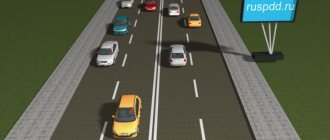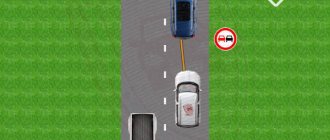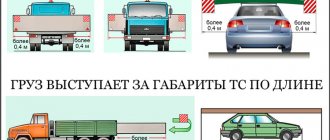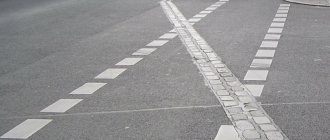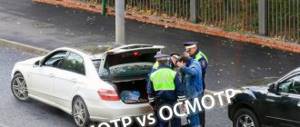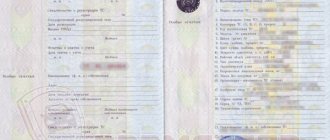What are the general maximum speed limits in 2021?
Many motorists believe that there are restrictions only in and outside populated areas (60 and 90 km/h, respectively), as well as on highways and in residential areas (110 and 20 km/h, respectively). Speed may also be limited by road signs. This is far from true, although on most roads in Russia these are the numbers.
Let's take a closer look at the different speed limit options!
In cities and towns
Inside a populated area, indeed, the general speed limit is 60 km/h according to traffic rules (clause 10.2 of the Rules). Moreover, a populated area is not determined by the presence of residential buildings or other buildings - their beginning and end are determined by road signs, like these:
But this is only true if you are driving on a public road outside the yard or adjacent territory, outside the coverage area of prohibitory and other signs and a number of other conditions. Let's look at what other options there may be.
- If you are moving through a courtyard or residential area, then you can drive a maximum of 20 km/h. This also includes a bicycle zone. Thus, if you see the following road signs, then this speed limit according to the traffic rules (clause 10.2) is for you:
- If you are towing another car, then you can drive not 60, but a maximum of 50 km/h (clause 10.4 of the traffic rules).
- In addition, if there is a speed limit sign on a given section of the road, then you can drive no more than the speed indicated on the sign. Please note that the limit may be more than 60 - in this case, the city administration recognized this area as safe and allowed traffic above the general limit. This is possible thanks to Note clause 10.2. However, in any case, such a relaxation cannot be higher than the established limit within populated areas - 110 km/h, that is, a sign in the city cannot have more than this value.
- And if you are that rare case, driving a slow-moving vehicle, then you cannot exceed the value indicated on the sign on this vehicle (most often 30 km/h).
Do you see how many subtleties there can be?!
You will also be interested in:
- Road speed signs on a blue background: what are the limits and the permitted speed?
- Can a driver's license be revoked for speeding? For what, according to cameras and how to get a fine?
- What is the coverage area of the speed limit sign?
On the highway - outside populated areas
But here there are even more restrictions. The general one is 90 km/h: in the absence of speed limit signs, if you are driving a car or motorcycle, are not towing a trailer or another car, and a number of other factors. Let's look at them all!
- So, the maximum speed of 90 km/h is set for the following vehicles (clause 10.3 of the traffic rules): cars,
- motorcycles,
- cargo vehicles with a maximum permitted weight (specified in the STS) of no more than 3.5 tons,
- intercity shuttle buses,
- small buses.
Below we will once again talk in more detail separately about highways and a number of other road sections.
Expert opinion
Yuri Panchenko
Driving instructor, human rights activist, author of books. 10 years of experience.
A car's speedometer readings can differ dramatically from its actual speed. According to clause 5.4 of UNECE Regulation No. 39, when testing speedometers, the speed indicated by the device should not be less than the actual speed of the vehicle.
There is also a formula according to which the actual speed intervals are calculated for different instrument readings. If the speedometer shows 60 km/h, then the actual speed will lie between 51 and 60 km/h. Accordingly, at 90 km/h – between 78 and 90 km/h, at 110 km/h – between 96 and 110 km/h.
It is highly desirable for drivers to know the real speed of their car at different speedometer readings, so as not to fall out of the flow. This can be done either using a navigator, or by connecting to the on-board computer.
Ask a Question
Maximum permitted speed on the highway, restrictions for different types of transport in Russia 2021
In Russia, the maximum permitted speed on highways does not exceed 100–150 km/h. Despite the fact that modern cars can easily accelerate to 200 km/h, they hardly need such power. In Russia there are practically no roads that meet GOST standards where you can accelerate well. Therefore, according to traffic rules, safe driving is possible only at lower speeds, depending on the route and transport. Let's take a closer look.
Subtlety exceeding 20 km/h
The above restrictions are conditional, aren’t they?! Indeed, many car owners believe that their speed according to the simple formula [current limit] + 20 km/h is an unpunished excess.
But it is not so. Indeed, in Article 12.9 of the Code of Administrative Offenses of the Russian Federation, which is responsible for fines and terms of deprivation of rights for speeding, you will not find liability for driving 20 km/h faster than the speed limit for a given section.
This does not mean that you can exceed with impunity. The fact is that the legislation contains not only administrative responsibility, but also civil responsibility. Simply put, each violation of all participants in an accident may be the cause of the accident and, accordingly, indicate a certain degree of guilt. This is what judicial practice in 2021 prescribes. That is, if, for example, they did not give way to you at an intersection, and you were speeding by 19 km/h, then the blame for the accident may be found to be mutual, and part of the blame may be placed on you.
It will be even worse if it is entirely your fault. In this case, speeding will be an aggravating factor when assigning liability. This is especially true when imposing criminal punishment, for example, under Article 264 of the Criminal Code of the Russian Federation, if a driver hits a pedestrian with at least serious harm to health.
Another subtlety of matching speed to road conditions
There is a tricky clause 10.1 in the Rules. It indicates that you must choose your speed based not only on the limits described above (and below), but also on road, weather and other conditions. And the main trick of this traffic rule is that it essentially shifts the responsibility to monitor the danger on the road, even if there should not be one, to the driver, saying that you must choose a speed that would ensure safety and the ability to slow down to full speed. stopping before a collision.
For example, you are driving in the dark with working headlights that illuminate the road ahead 20 meters. And your (also fully functional) braking system will provide a braking distance of 25 meters at a speed of 90 km/h (average values from traffic tickets). That is, it turns out that, moving at the permitted speed of 90 kilometers per hour along the highway in the absence of limit signs, you will not have time to notice a dark object in such a way as to stop without colliding with it. Therefore, you are violating clause 10.1.
Violations of this clause are often issued by traffic police officers when the driver drives into a standing (parked) car, a hole, a hatch, a pothole in the road, an open hatch, a wild animal and other objects and living creatures on the road that essentially should not be on it.
Permitted speed for certain types of transport
Maximum values also vary depending on the type of transport.
For trucks
As a rule, the maximum permitted speed for trucks is lower than for ordinary cars.
Category B trucks are limited to the following values:
- on the highway - no more than 110 km/h;
- on normal roads - no more than 90 km/h;
- in populated areas - no more than 60 km/h.
How can road signs change the speed limit?
With signs that reduce the permissible speed, everything seems to be clear: if we are driving in a city within the coverage area of the prohibitory sign “40”, then we can drive no more than 40, and not 60 km/h, since the road sign has priority.
We learned above that by this means local authorities can increase the permitted speed. For example, on a highway up to 110 km/h by installing the appropriate sign. And this is completely legal.
There is also a sign 5.31, indicating the restricted area. That is, it does not extend to the nearest intersection (or other places that interrupt its coverage area), but to another sign that cancels its effect. Here's what they both look like:
Thus, when you see such a sign, you need to remember further that you are within the speed limit of 30 km/h and drive no faster until you meet the sign 5.32 (to the right in the picture above).
Expert opinion
Dmitry Tikovenko
Automotive law expert. 7 years of experience. Areas of specialization: civil law, disputes over compulsory motor liability insurance and road accidents
If the speed on a section of road is limited by more than 20 km/h compared to the maximum on the previous section, according to GOST R 52289-2019, a stepped speed limit must be applied, with each step no more than 20 km/h. At the same time, signs should be placed at a distance of 100-150 meters outside a populated area and 50-100 meters in a populated area.
Often, due to violation of the placement of signs on the road, drivers do not have time to brake to the required “mark”, where a camera or a traffic police ambush may be waiting for them.
Ask a Question
What does markup restriction mean?
It happens that the current speed limits are established not only by signs, but also by special markings - 1.24.2. This is what she looks like:
If it is available, you must adhere to the speed limit indicated on it. And you won’t be able to do it any other way. The fact is that such markings themselves exist only to duplicate the corresponding prohibitory road sign. Moreover, according to GOST 52289-2019, it can only be applied in the same place where the sign is located.
But there is one exception! Such markings may also indicate a speed limit in the area covered by sign 5.31 described above. In this case, it is applied after each intersection (but is not required for this) - clause 6.2.29 of the specified GOST. Then you must also adhere to a speed no higher than that indicated on the markings.
In other cases, if the road is marked with a speed limit, but there is no prohibitory sign along with it, then in fact it has no legal force, and you are not obliged to follow it.
Maximum speed of a truck for transporting passengers
Transporting people in the back of a truck is quite dangerous, so it must be equipped accordingly, namely, have a body with seats and a boarding ladder. The seats must be strong and well secured, and the boarding ladder must be secured to the rear side of the truck bed.
When transporting passengers in a truck, the driver must be especially careful when turning to avoid the possibility of injury to them. For the same reason, the speed limit for trucks of this kind is quite strict; the maximum speed can reach 60 km/h. The same rule applies when transporting children.
On the motorway
Above, we described in detail the speed limit when driving on highways outside populated areas. However, if this area is equipped with a highway sign, then these rules change somewhat.
- The general speed limit according to traffic regulations on highways is 110 km/h (clause 10.3). Passenger cars without trailers, motorcycles and trucks weighing up to 3.5 tons can move at this speed.
- Any buses can travel no more than 90 km/h.
- The same limit is established for cars with trailers and trucks weighing over 3.5 tons.
- If the truck is carrying people in the back, then the limit is reduced to 60 km/h. The same rule applies to buses carrying children in an organized manner.
- The maximum towing speed on the highway is 50 km/h.
- If the legislators of this section of the road decided to increase the permitted speed, then they can do this, but not more than up to 130 km/h (this is generally the maximum “maximum speed” allowed for installation on public roads in Russia). However, this restriction also applies only to motorcycles, cars and trucks up to 3.5 tons.
Separately, we note the minimum set speed on highways. Even teachers in driving schools often teach that it is 40 km/h. This is not true - there is no such thing in the current traffic rules for 2021. There is only a rule (clause 16.1) that vehicles whose design maximum speed is less than 40 km/h cannot drive onto such a road. But driving slower in other vehicles is not prohibited.
Speed limits at the entrances to and exits from populated areas
According to the traffic rules, populated areas are built-up areas, the beginning and end of which are indicated by road signs 5.23.1 – 5.26. These signs exist to designate the territory within which it is necessary to adhere to the speed established specifically for cities and other types of populated areas.
But it is important to take into account that the restriction comes into force only if there are signs 5.23.1 and 5.23.2 indicating the beginning of this territory. Other similar signs indicate that the rules established for a built-up area do not apply on this section of the road.
Signs 5.23.1 – 5.26
Thus, when passing a sign indicating the entrance to a built-up area, the driver is obliged to slow down to 60 km/h, in accordance with section 10 of the traffic rules. Driving at this speed must continue until a sign indicating the exit from a populated area or other speed limit sign, such as sign 3.24.
The end of a populated area (city, town, village) is indicated by road signs 5.24.1 and 5.24.2. After crossing them, the driver has the right to move at the speed allowed for routes that are outside the city and other populated areas.
What is the maximum limit?
The highest maximum speed that can be on Russian roads is 130 km per hour. This is only possible on motorways and only on sections of roads.
Yes, separate closed tracks are possible, where there may be no restrictions at all. But the free access of cars to them is, as a rule, limited.
Something else useful for you:
- Road sign “Parking prohibited” according to traffic regulations: what is the coverage area, where and who can park?
- What are the penalties for towing violations? Traffic regulations on flexible and rigid coupling
- What new traffic police fines for speeding have come into force?
2021 Speed Limit Summary Table
So, let's now summarize and consider in tabular form all kinds of speed limits on different sections of roads and for different vehicles.
Speed limit table
| Road section | Current traffic restrictions |
| Residential area, no restrictions signs, you are not in a residential area, courtyard or bicycle area | 60 km/h 50 km/h – when towing another vehicle |
| In residential areas, courtyards and cycling areas | 20 km/h |
| There is a speed limit sign | The maximum limit is limited by this road sign |
| Slow moving vehicle | On all roads, no more than the speed indicated on the sign on this slow-moving vehicle |
| Outside built-up areas, unless it is a motorway and there are no speed limit signs | 90 km/h – for motorcycles, cars and trucks weighing up to 3.5 tons, intercity and small buses 70 km/h – for cars with a trailer, route buses and trucks over 3.5 tons 60 km/h – for trucks carrying people in the back, as well as during organized transportation of children 50 km/h - for vehicles towing another vehicle |
| On a motorway in the absence of road restrictions signs | 110 km/h - for motorcycles, cars without a trailer and trucks up to 3.5 tons 90 km/h - for buses, trucks over 3.5 tons 60 km/h - for carrying passengers in the back of a truck and for the organized transportation of children 50 km/h – when towing |
| If there is markup with a limitation | The limit indicated on this marking. It duplicates the speed limit sign, except when it is posted at an intersection within the coverage area of the sign 5.31 |
| Large, heavy trucks and those carrying dangerous goods | The limit is set in the accompanying documents |
What is the maximum speed of a vehicle in the suburbs?
Driver's license - When is overtaking a vehicle in front allowed? If there is no obvious threat of collision.
— When you see a vehicle with the special switch on. Is the driver required to signal? Gradually reduce speed and pull to the side of the road.
— What should be done first in the event of an accident? Stay where you are and call the software staff.
— When can you turn on high beam headlights in the city? On the road.
— Is overtaking allowed with a double solid line? Prohibited.
— What is the maximum speed of a vehicle on a highway? 150 km/h.
— What is the maximum speed of a vehicle in the suburbs? 110 km/h.
— What is the maximum speed of the vehicle in the city? 60 km/h.
— Is it allowed to overtake vehicles in front of you in the city? Allowed if there is no threat of collision.
- When should you wear a seat belt? Anyway.
— Is reversing allowed on the highway? No, not allowed.
— In what place does the driver have the right to park? In the parking lot.
— Is it worth observing the load capacity of the tractor? Yes, always.
— Is it necessary to look in the rearview mirrors when reversing? Necessarily.
— What type of intersections are installed in the state? Unregulated equivalent roads.
— Is it possible to install special signal for a personal car? No you can not.
- At what age can you get water? rights? From the age of 18.
— What is a traffic accident? Road traffic accident.
— What should a driver do when crossing an intersection? Reduce speed and drive through when there are no obstacles.
— In what cases is overtaking on the right allowed? Allowed if the vehicle in front is turning.
— In what case should you turn on the emergency signal? In case of an accident.
- Should government officials be visible? car number? Must be in front and behind.
— Is overtaking allowed on broken lines? Always allowed.
— Is it mandatory to stop before a pedestrian crossing? Mandatory.
— Is it allowed to turn a vehicle in the tunnel? No.
Air - At what age are you allowed to fly air transport? 18 years.
— Driving an aircraft while under the influence of drugs or alcohol? Prohibited.
— What is prohibited when operating air transport? Talk on the phone and be distracted from control.
— What should you do when approaching another aircraft? Lean 30 degrees to the right.
— Speed limit for air transport? Absent.
— Limitation of the flight altitude of air transport? Absent.
— Flights over military bases for civilians? Prohibited.
— Performing aerobatic maneuvers? Allowed from 21 years of age.
Source
How much is the fine for exceeding?
All measures of liability for violations of the speed limit are established by Article 12.9 of the Code of Administrative Offenses of the Russian Federation, different parts of which establish their own penalties for the amount of excess.
2021 Speeding Fines Table
| Excess by amount | New fines |
| From 0 to 20 km/h | No punishment |
| From 20 to 40 km/h | 500 rubles (Part 2 of Article 12.9 of the Code) |
| From 40 to 60 km/h | From 1,000 to 1,500 rubles (part 3) |
| From 60 to 80 km/h | 2,000 – 2,500 rubles or deprivation of rights from 4 to 6 months (part 4) |
| More than 80 km/h | 5,000 rubles or deprivation of rights for six months (part 5) |
| Repeated excess of 40-60 km/h | 2,000 – 2,500 rubles (part 6) |
| Repeated excess of more than 60 km/h | 5,000 per camera or deprivation of rights for 1 year (part 7) |
In addition, in our country there is a fine for exceeding the average speed. This is when 2 photo recording cameras, located at a predetermined distance from each other, film a car and, using time, calculate its speed between them. The Supreme Court once declared such punishments illegal, however, in practice they are still imposed.
Speed of a truck outside populated areas and on their territory
Freight transport is an indispensable assistant; it is used to transport cargo throughout the city and beyond. It is impossible to imagine how construction and international trade would be carried out without trucks. Trucks are used to transport almost any cargo, and the speed limit of a given particular truck depends on the type and weight of the cargo being transported.
The average technical speed of a truck is an important parameter that allows you to save time and money. It determines the speed while the car is in motion, taking into account all types of stops along the way. The average speed of freight transport is an important tool for logistics and truckers. The condition of the road and the car itself, the intensity of traffic on the route - everything affects the value of this parameter; it is determined by the ratio of the distance traveled by the car to the time of movement. A skillful driver chooses his route in such a way that this relationship has maximum significance.
Trucks can be classified according to different parameters, but if we take into account the speed of the vehicle, this transport is divided into:
- trucks that transport people;
— trucks of category B, the cargo weight of which does not exceed 3.5 tons;
— trucks with categories C and CE (carrying cargo weighing more than 3.5 tons).

